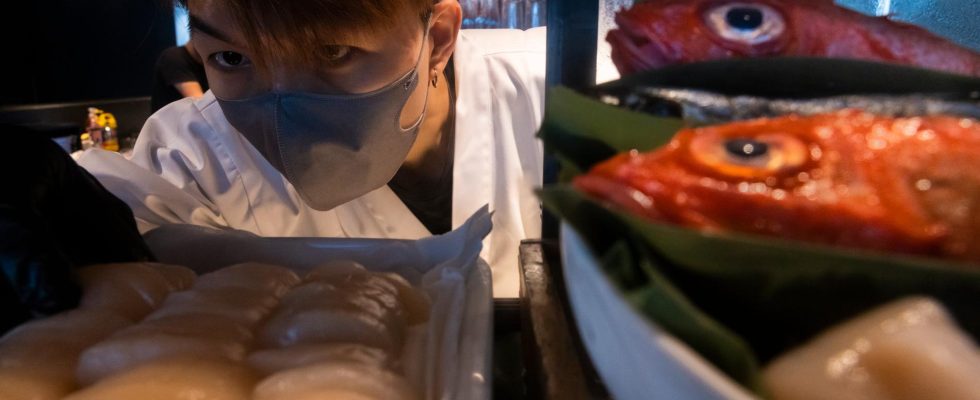1 / 3Photo: Louise Delmotte/AP/TT
South Korean politicians are on hunger strike, China is threatening a boycott and Japanese fishing organizations are standing in the way.
At the end of August, cooling water from the nuclear power plant in Japan’s Fukushima is expected to be emptied into the sea. But the decision is met with protests despite the fact that the radioactivity in the water is not dangerous.
Over a thousand round tanks are lined up in the nuclear power plant area in Fukushima. The number has grown as the years have passed since the nuclear plant was hit by a tsunami in 2011, causing the worst nuclear accident in the world since Chernobyl.
The melted radioactive fuel has still not been taken care of and a first step is to get rid of the large water tanks. They contain roughly 1.3 million cubic meters of water – partly old cooling water from the time when the nuclear power plant was in operation, partly rainwater and groundwater that constantly seeps into the broken facility and then becomes radioactive.
But soon there is no room for more thoughts. This complicates the work of decommissioning the facility and the radioactive water also risks ending up in the sea uncleaned, in case new natural disasters occur.
Therefore, the Japanese government has decided that the water should be purified and then pumped into the sea.
– It is a big milestone for us, says Junichi Matsumoto, head of water management at the energy company Tepco, which has the nuclear power plant in Fukushima, to AP.
Radioactive particles must be removed and the water diluted. The radioactive substance tritium is difficult to remove, but has a shorter half-life than many other radioactive substances, only 12 years, which means that it disappears over time. The plan has been reviewed by the UN’s international atomic energy agency IAEA and the values are not higher than the cooling water that nuclear power plants in operation are normally allowed to discharge.
Resistance to the discharge
But the neighboring countries protest against the emissions. China and Hong Kong threaten to boycott Japanese fishing products. In South Korea, the government accepts the emptying, but South Koreans are demonstrating and an opposition politician has been on hunger strike for two weeks in protest. And North Korea criticizes the IAEA because the organization allows the emissions.
Even in Japan there are groups that are against it, AP reports. Japanese fisheries organizations are concerned that the spill will further tarnish the reputation of the country’s seafood. And Yukinaga Suzuki, 70, who houses tourists on a beach about five miles from the nuclear plant, hopes the releases will only happen when the swimming season is over.
– Without a clean sea, I cannot survive, he tells AP.
Apart from tritium, about 20 other radioactive substances will be released into the sea, which otherwise do not usually end up in the cooling water of nuclear power plants, Katsumi Shozugawa, professor of chemistry, told AP.
– If you ask about their impact on the environment, we can honestly just say that we don’t know. But it is true that the lower the concentration, the less environmental impact, he says, adding that the plan is probably safe.
Low radioactivity
The Swedish Radiation Safety Authority has confidence that the emissions are safe.
– They meet the Japanese criteria for emissions. The levels are less than one ten-thousandth of the radioactivity that you get naturally from the radiation found in the ground, space and in the body, says Pål Andersson, investigator at the Radiation Safety Agency, to TT.
He believes that emissions and radioactive substances always cause concern.
– But maybe it will be more noticeable if you have collected the water in a tank, than if you let it out running.
FACT This is how much radioactivity you ingest naturally
The water to be released from the nuclear power plant in Fukushima is estimated to give a radiation dose of 0.04 microsievert per year for those who eat a lot of fish from the area. Anyone who does not eat fish at all is not expected to ingest radioactive substances from the emptying.
The radiation that we all naturally absorb from space, land, food and our own bodies is on average just over 1,000 microsieverts per year.
Flying round-trip to, for example, the USA means that you receive a radiation dose of approximately 100 microsieverts.
Source: Radiation Safety Authority.
Read moreFACTSThe disaster in Fukushima
On March 11, 2011, a magnitude 9.0 earthquake occurred in the Pacific Ocean, causing a tsunami.
The tsunami had destroyed the Fukushima Dai-ichi nuclear power plant in northeastern Japan, leading to three meltdowns. It is the biggest nuclear accident since Chernobyl in Ukraine in 1986. Residents within a radius of 20 kilometers from the nuclear power plant were evacuated.
Around 18,500 people died or are missing after the earthquake and tsunami. Japan’s government has so far confirmed a single death from radiation at the Fukushima plant in connection with the accident, but the evacuation after the meltdowns is estimated to have indirectly caused over 2,000 deaths from disease and suicide.
The country’s economy was also hit hard as consumer confidence in products from the area declined sharply. The tourism industry was also affected, with significantly fewer tourists in the area during the 2010s.
Read more
